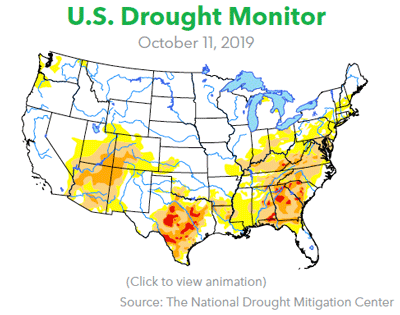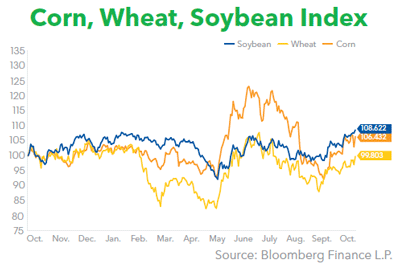 Eastern Cornbelt:
Eastern Cornbelt:
As with most of the Midwest and Central Plains, the Eastern Cornbelt was expecting significantly lower temperatures as the week progressed. Lows down to the mid-30s were in the Oct. 11 forecast for central Illinois, with rain moving through parts of the state late on Oct. 10.
Up to a half-inch of rain was expected on Oct. 11 in central Indiana, with temperatures dropping to unseasonable lows after 32 consecutive days of above-normal temperatures. In northern Ohio, too, highs were predicted to only reach the 50s and 60s over the weekend, with showers moving through many parts of the state.
USDA reported that 11-15 percent of the regional corn crop was harvested by Oct. 6, well behind the average pace. The soybean crop was at a similar stage, with 11-18 percent of the acreage harvested in the region. USDA assigned good or excellent ratings to 43-46 percent of the corn and soybeans in Illinois, compared with 32-34 percent in Indiana and Ohio.
Western Cornbelt:
A strong cold front was expected to impact much of the Western Cornbelt late in the week. Heavy snow was in the forecast for parts of the Dakotas, with cold air from that system – along with 40 mph wind gusts – expected to push temperatures down to below freezing on Oct. 11-12 in parts of Iowa.
Much of Missouri was also under a freeze watch for the weekend, but Nebraska was bracing for the biggest impact. Lows were expected to drop into the 20s and low-30s in parts of the state on Oct. 11-12, with a mixture of rain and snow in the weekend forecast for areas of northern and central Nebraska.
Sources reported “a little harvesting” underway in Iowa during the week, but the pace was expected to stall with the incoming moisture and cold temperatures.
Just 3 percent of Iowa’s corn was harvested by Oct. 6, compared with 12 percent in Nebraska and 35 percent in Missouri. The soybean harvest was 5-6 percent complete in Iowa and Missouri by that date, compared with 14 percent in Nebraska. USDA placed fully 73-74 percent of Nebraska’s corn and soybeans in the good or excellent categories, compared with 64-65 percent in Iowa, and 45-53 percent in Missouri.
Missouri’s rice crop was 84 percent harvested by Oct. 6, but only 7 percent of the state’s cotton crop had been picked by that date, with just 19 percent of the cotton rated as good or excellent. Nebraska growers were just starting the sorghum harvest, with 4 percent of the crop in the bin and fully 81 percent of the acreage rated as good or excellent.
 Southern Plains:
Southern Plains:
Much cooler weather was reported across the Southern Plains as the week advanced, along with storms in some locations. The previous weekend brought heavy rains to the Tulsa area, which caused river flooding in some locations.
Highs in the 70s were reported in Kansas at midweek, but a strong cold front brought thunderstorms and then unseasonably low temperatures, with wind chills expected to drop into the 20s by Oct. 11. The season’s first frost was expected across a wide swathe of the state on that date, along with a dusting of snow in some parts of northern Kansas.
Snowfall also hit Colorado’s Front Range on Oct. 9, with record lows expected in Denver on Oct. 11. Temperatures in the 50s were reported in northern and central Oklahoma at Oct. 10, with reports of wind and hail in some locations. Wind chills in the 30s were expected in Oklahoma City on Oct. 11.
Although the week began with temperatures in the low- to mid-90s across northern Texas, highs were only expected to reach the 50s and possibly low-60s on Oct. 11. Forecasts also called for showers and thunderstorms in parts of Texas on Oct. 10.
Harvest was underway on a wide range of crops in the Southern Plains, with quality described as mixed. “Cotton defoliation is going on in the High Plains,” commented one Texas source at midweek. “High heat late in the season has hurt the corn crop. We were thinking 200+ bushels/acre, but now it’s looking like 150 bu/a on corn.”
The corn harvest as of Oct. 6 was estimated at 17 percent complete in Colorado, 36 percent in Kansas, and 74 percent in Texas, with good or excellent ratings assigned to 72 percent of Colorado’s crop, 62 percent in Kansas, and 52 percent in Texas.
Kansas growers also had 5 percent of the soybeans and 7 percent of the sunflowers harvested by Oct. 6, with 57 percent of the soybean crop rated as good or excellent. The cotton harvest, while not yet started in Kansas, was 25 percent complete in Texas, with good or excellent ratings assigned to just 16 percent of Oklahoma’s crop, 30 percent in Texas, and 47 percent in Kansas.
Sorghum quality was considerably better in the region, however, with 61-71 percent of the acreage rated as good or excellent. The sorghum harvest as of Oct. 6 was 87 percent complete in Texas, 24 percent in Oklahoma, 17 percent in Colorado, and just 10 percent in Kansas.
South Central:
A strong cold front was taking aim at the South Central region later in the week, and was expected to plunge temperatures to near freezing in Arkansas, Tennessee, and Kentucky.
As much as 5-10 inches of rain hit northwestern Arkansas on Oct. 6, prompting flash flooding in many locations. Highs climbed to the 80s again at midweek, but another round of showers and gusty winds on Oct. 10 dropped temperatures from the 60s and 70s down into the 40s and 50s. Lows into the 30s and 40s were expected in northern Arkansas on Oct. 11.
A similar weather change was taking place in Tennessee and Kentucky, where parts of central and eastern Kentucky collected up to 1-3 inches of rainfall as the week began. Highs in both states were expected to drop from the 80s down to the low-60s on Oct. 11-12, with some areas bracing for lows in the 30s and 40s by Oct. 13.
The region was “in full harvest” at mid-month, according to sources, with generally favorable crop conditions reported. “We were actually very dry in the Mid-South until we got some moisture the last couple of days,” said one regional contact.
USDA said 80-98 percent of the regional rice crop was harvested by Oct. 6, and 76-88 percent of the corn was harvested in Kentucky and Tennessee by that date, with both states tracking ahead of their average pace. Good or excellent ratings were assigned to fully 85 percent of Tennessee’s corn crop, compared with 65 percent in Kentucky.
The soybean harvest was rated at 80 percent complete in Louisiana, 58 percent in Mississippi, 38-39 percent in Arkansas and Tennessee, and 31 percent in Kentucky, with good or excellent ratings assigned to 64-66 percent of the acreage in Louisiana and Mississippi, 57-59 percent in Arkansas and Tennessee, and 47 percent in Kentucky.
The cotton harvest as of Oct. 6 was 51 percent complete in Louisiana, 41 percent in Arkansas, 37 percent in Mississippi, and 22 percent in Tennessee, with all states but Louisiana tracking ahead of their five-year averages. USDA rated fully 83 percent of the Arkansas cotton crop as good or excellent, compared with 60-63 percent in the rest of the region.
Southeast:
Harvesting was well underway in the Southeast region in early October, although some areas were hit with rain during the week. Heavy rain and thunderstorms developed across central and southern Florida on Oct. 8, and northern Alabama was bracing for precipitation on Oct. 11 from a strong cold front moving across the country.
An early nor-easter was expected to bring high winds and 5-8 inches of rain to parts of New England over the coming weekend, with North Carolina also bracing for possible coastal flooding along the northern Outer Banks.
Extremely dry conditions in recent weeks allowed growers to make quick progress on the harvest of corn, soybeans, cotton, and peanuts, but one source said “yields have fallen off” as a result. North Carolina’s corn was 91 percent harvested by Oct. 6, along with 17 percent of the state’s soybeans, with 41-44 percent of the acreage rated as good or excellent.
The regional cotton harvest was progressing ahead of normal, with 25-28 percent of the crop picked in Alabama, Georgia, and South Carolina by Oct. 6, compared with 16-18 percent in North Carolina and Virginia. USDA rated fully 72 percent of Virginia’s cotton as good or excellent, along with 62 percent of the crop in South Carolina, 49-53 percent in Alabama and Georgia, and 34 percent in North Carolina.
The peanut harvest was also ahead of schedule, but with the moisture content at just 6-8 percent, sources said growers in some areas were shelling at night to try to pick up some extra moisture. Harvest progress as of Oct. 6 was estimated at 56-60 percent in Alabama, Florida and Virginia, 46 percent in Georgia, and 33-37 percent in the Carolinas, with good or excellent ratings assigned to 80 percent of the crop in Virginia, 59-60 percent in the Carolinas, 47-54 percent in Alabama and Georgia, and just 36 percent in Florida.